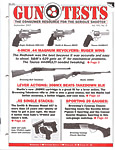
.45 ACP Single-Stack Pistols: S&W Pulls Out a Surprise Win
The $711 aluminum-frame Smith & Wesson Model 457 has been in the catalog since 1996, but we preferred it over two newer polymer guns, the $697 Kahr TP4543 and the $620 Glock G36.
Gun Tests , September 2007, p. 18 - 22
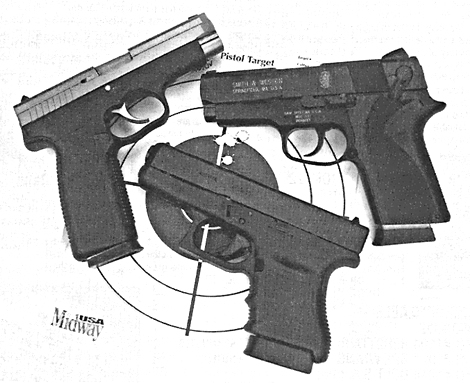
Our trio of non-1911 single stack .45s were (clockwise from upper left) the Kahr TP4543, Smith & Wesson's 457, and the Glock G36 – three different guns with three different interpretations of double action operation. The Kahr had a very long trigger pull with little or no feedback. The Glock's trigger pull was shorter and heavier. The Smith & Wesson pistol fired first-shot double action with single-action fire afterward. But decocking also deactivated the trigger until reset manually. The Glock landed this one-inch group of five shots, but note its location high above our 6 o'clock point of aim. This was not a product of the sights but rather recoil control.
Chances are that whenever a pistol is described as being a single-stack .45, it will automatically be assumed that the handgun in question is a Browning 1911. But that isn't always the case. Not every .45 semi-auto that feeds from a single-column magazine was meant to be carried cocked and locked. Nor does every single-stack .45 operate with a single-action trigger.
To wit: In this test we will evaluate three single-stack .45s that operate with a hinged trigger, with at least the first shot being fired double action. The $711 Smith & Wesson Model 457 has been in the catalog since 1996. The 457 is a traditional double action (TDA) pistol that once charged, can be "decocked" to both raise and drop the hammer on the first shot. Both the $697 Kahr TP4543 and the $620 Glock G36 are striker-fired pistols that define double action in a less traditional manner.
Nevertheless, the benefits of a single-stack pistol were in place throughout. All were narrow, making them easier to conceal, and their slim profiles offered a rectangular sensation to the hand. Our staff agreed that this helped them point the gun at the target more quickly. All three guns were snag free, and thanks to the use of polymer and aluminum alloy, each pistol was lighter in weight than most big-bore handguns. Please note that in regards to how we measured the front strap and the overall height of our test guns we chose a slight variation in protocol. Since each of our guns relied upon their magazines to either complete or extend their grips, we measured with the magazines in place.
In choosing our test ammunition we took a cue from the July 2007 test of the Sigarms P220 SAO. In that test we learned that our best choice for rapid fire was the 185-grain Hornady XTP/JHP round. Accordingly, we again chose these 185-grain Hornady rounds plus 185-grain silvertip hollowpoints from Winchester. With so much rain falling in Houston, we shot the guns indoors at Top Gun of Texas (topgunrange.com). So we packed some Winchester 185-grain BEB WinClean ammunition as well.
The pistols were tested from a distance of 15 yards. We used a sandbag rest to support each gun and reduce shooter error. In this way we could tell more about the machines themselves and determine the level of accuracy available from each gun.
We also let our staff shoot each pistol in what we call a 557 test. By 557, we mean five shots standing unsupported offhand, with a maximum time limit of five seconds from a distance of seven yards. The goal of the shooter was to land the tightest five-shot group in the given time period. Our point of aim was the 3-inch circles along the margins of the Hoffners ABC16 target (hoffners.com). In this way, we were able to better ascertain what was required of the operator to shoot each gun effectively. Let's see which of our test guns did the most to help us get the job done.
Smith & Wesson Model 457 No. 104804, $711
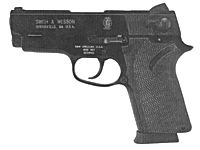
SMITH & WESSON M457 NO. 104804 .45 ACP, $711
GUN TESTS GRADE: B
The controls of this gun may be unnecessarily complicated, but so much is right with the way it fits the hand.

After pressing the decocker, the lever remained in its down position, deactivating the trigger. The lever had to be pushed upward to its 9 o'clock position to re-engage the trigger for first-shot double-action fire.
The Model 457 is one of the oldest remaining products in the Smith & Wesson catalog. Also available with a matte stainless finish (model number 457S), this design is closely related to the "Second Generation" pistols that were popular with law enforcement when semi-automatics first replaced the revolver. What we liked best about the 457 was the way it lined up in our hands. The distance between the face of the trigger and the rear of the grip was just right, even when the trigger was in its rearward position for single-action fire. The plastic grip looked and felt like it was part of the aluminum frame. The seven round magazines included a basepad with a pinky rest, so even those shooters with the largest hands were satisfied.
The stealth black finish turned out to be very durable, and it remained unmarred throughout our tests. The right side of the gun was devoid of graphics and levers. We did however spy an externally mounted extractor flush fit with the slide, which also featured cocking serrations to the rear only. The left side showed off-white-colored lettering, a slide stop, and a decocker/safety lever mounted on the slide. The decocking lever was used to drop the hammer safely over a chambered round. After pressing the decocker, the lever would remain in its downward position deactivating the trigger. To return to safe-off, first shot double action required that the shooter manually push the lever upwards. The hammer on the 457 was without a tang or spur, and after decocking remained nearly flush with the back of the slide. An additional safety was the magazine release. With the magazine removed or simply ajar, the trigger was once again disconnected.
Sights were a low-mount snag-free design mounted via dovetails in the slide at both the front and rear. Sight acquisition was aided by white dots on the front blade and the rear notch.
Firing single action only from support, we established two benchmarks of note. The measurement of our five-shot groups averaged 1.7 inches firing both the Hornady and Winchester WinClean ammunition and 2.0 inches across shooting the Winchester Silvertips. The length of the 457's barrel was measured to be slightly less than 3.75 inches and the Glock's barrel measured slightly more than 3.75 inches. Overall average velocities for both pistols were about the same. But in terms of recoil control, we felt that the Smith & Wesson far outstripped the Glock. Naturally, the metallic frame of the 457 furnished more weight than either of our polymer pistols, but we think the larger contributing factor was the superior grip of the Smith & Wesson that we felt provided a more natural angle than the Glock.
In our 557 test, the Smith & Wesson was the top performer, even though our shooters were challenged with a transition from double to single action after the first shot of every group. Group size averaged about 3.75 inches across. What distinguished these groups from those fired by its competitors was that they were centered on the point of aim. The consensus of our staff was that of the three test guns, the Smith & Wesson offered the least variation in feel from the moment the trigger was acquired to the point of dissipation of recoil, and that the transition from double to single action forced only minimal adjustment upon the shooter. What we did argue about was the additional step presented by the combination decocker/safety lever. For example, during a training exercise, once the gun is taken off target, the command is, "Finger off the trigger, outside the trigger guard. Safety on if you have one; decock if you have decocker." The 457 design offered two choices here. They were to decock and raise the lever manually for next shot double action, or to press the decocker and leave the safety on.
For members of our staff favoring today's double-action-only pistols, the extra step seemed unnecessary. The intention of this design was to add an extra layer of safety. So was the magazine release, which disconnected the trigger. This feature has been used to foil gun grabs. Rather than prolong a fight for the weapon, the gun could be rendered useless by hitting the magazine release while the officer goes on to acquire an alternate weapon. Operators that would rather have the ability to fire an emergency shot in the middle of a reload should, however, be comforted by the fact that we thought the Smith & Wesson 457 was the most controllable when fired offhand.
Kahr TP4543 .45 ACP, $697
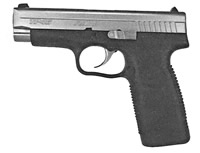
KAHR TP4543.45 ACP, $697
GUN TESTS GRADE: C
If you can dedicate yourself to this pistol and stay in practice, we think you will rate it much higher. But the long trigger may eventually become tiresome.
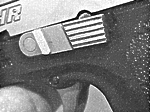
One difference between Kahr's steel-framed "K" models and their P/PM polymer pistols is the way in which the slide stop was removed. The TP4543 used the smaller relief in the slide.
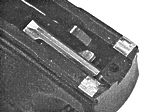
The polymer frame accounted for only 4.8 ounces of the Kahr's total weight. Key points were the rear guide rails and the cocking cam, (center).
Chambering the Kahr design for .45 ACP is the latest endeavor for Kahr Arms of Blauvelt, New York, which is located about 30 miles north of New York City. Three different .45s are available with barrel lengths of 3.14 inches, 3.54 inches, and 4.04 inches. All the .45s currently in the Kahr catalog utilize a polymer frame, including our test gun, the TP4543, which is the largest of the three.
Despite its size, the TP4543 was found to be so slim that we had no problem concealing it in a belly band underneath a T-shirt. The slide was a matte stainless steel with rear cocking serrations only and a short-stemmed external extractor seated flush on the right side.
Sights were dovetailed into place front and rear with a white dot up front and a vertical line underneath the rear notch.
The black polymer frame featured a pebble finish on both sides and some very effective stippling molded into the frontstrap and the rearstrap areas. The grip was very long, and the basepad of the seven-round magazine added a pinky rest that we think only the largest of hands will be able to use.
The only lever that spoiled the slim profile of the Kahr was the slide stop/release found on the left side. To break down the TP4543 for lubrication before we began our tests, we moved the slide rearward to align the pin with the relief on the left side of the slide. Here is where Kahr's polymer pistols differ from their steel-framed "K" series. To break down a K series pistols, you must align the forward portion of the stop along the axis of the cross pin itself. But the "P" or "PM" Kahr pistols require alignment of a tab found to the rear of the slide stop. This tab is only visible when it is aligned with the smaller relief located about one inch to the rear of the larger cutout along the bottom edge of the slide. With the stop removed, the trigger must be pulled to release the slide from the frame.
Underneath the top end, we found a full-length solid metal guide rod, a very long single filament recoil spring and the barrel. The frame itself weighed only 4.8 ounces and contained little more than the trigger, transfer bar, and a set of sears to interact with the striker. Underneath the slide, a draw bar used to compress the spring surrounding the striker was visible. In the case of the Kahr design, the double action was the final compression of this spring followed by the release of its energy to drive the striker forward into the primer of the chambered round. Take-up of the Kahr's trigger was, however, a long process. Indeed, the long take-up of the Kahr trigger is its only active safety.
We could not really define the trigger feel of the Kahr pistol because there wasn't one. For example, in our test of .44 Magnum revolvers earlier in this issue we noted that the double action press of the Ruger Redhawk was defined by accompanying sounds and sensations such as the clicking of stops and sears and actually seeing the cylinder rotate. The lack of such cues is precisely what makes the double action semi-automatic trigger less predictable.
Striker-fired pistols offer even less sensation. To this end, once the Kahr's trigger was pressed, we found it difficult to safely cancel a shot and release the trigger.
The best advice we could offer was once the press had begun, the Kahr shooter must follow through. Taking this advice to heart we were able to achieve, if by a narrow margin, the best accuracy from support of this test. The overall range in group size for all shots fired was 1.1 inches to 2.0 inches.
In terms of recoil the Kahr was a very comfortable gun to shoot. But we rated it behind the Smith & Wesson 457 for the following reason. The trigger fingers of our staff crossed the face of the trigger so far during the long press that it often contacted the frame on the other side. Fundamentals say it is best to press the trigger with only the pad of the index finger, but the seven pounds of resistance spread over such a long movement tempted the shooter to use much more finger to bring the action to its break. In our 557 drill, this caused us to push more shots off target than we liked.
Oddly, we thought that the Kahr TP4543, the largest gun in the test, might actually be better suited for someone with smaller hands. Perhaps a smaller hand would find it easier to keep the trigger finger closer to the center and prevent pushing shots to the side. In the end our staff agreed that the Kahr pistol was a pretty good piece of hardware that nonetheless demanded dedicated practice. To take advantage of its capability, the shooter would be best served by not training with other pistols that would leave them out of practice for firing the Kahr.
Glock G36, $620
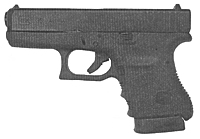
GLOCK G36 .45 ACP, $620
GUN TESTS GRADE: C+
Casual shooters will find the G36 to be a handful, thus the C+, but Glock aficionados might rate the gun a B+.
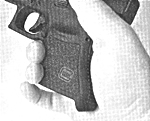
Because the grip of the Glock 36 was useless without the magazine, we decided to measure overall height and the front strap with the magazine in place.
Recently, we were told by a Glock representative that, despite rarely being seen or talked about, the G36 was one of the company's most popular guns for concealed carry, especially by police. Such irony should not go unnoticed.
The G36 is in fact the only single stack in the Glock catalog. It was very small top to bottom, about an inch less than our other guns when measured from magazine basepad to the top of the rear sight. But the barrel was nearly four inches long and thanks to where the sights were mounted on the slide, sight radius was nearly six inches in length. The front strap included only two finger grooves, but the bulky base extended the grip and added support for the pinky. Magazine capacity was six rounds. The palm swell at the rear of the grip fit directly into the hollow of the palm. The magazine release appeared to be slightly oversized but did not cause the magazine to be released accidentally. The slide release was the only other control in evidence and thanks to a frame contour buffering the release's modest profile, the G36 was snag-free.
Underneath the slide was a short barrel with a large hole in the muzzle plus a recoil assembly with two captured springs. This meant that a quick field-stripping resulted in a short list of parts consisting of only the barrel, recoil assembly, the slide, and the frame. In our estimation the slickest part of the Glock design was that in reassembly the slide seated itself and locked into place automatically when it was applied to the frame.
The Glock action can be considered a double-action pistol because the trigger performs two jobs. Much like in the Kahr design, pressing the trigger produced the final compression of the striker spring and the release thereof. In terms of an active safety, the Glock relied mostly upon a long trigger movement. The takeup of the Glock's trigger felt shorter than that of the Kahr pistol, but it had more feel and its 8.5 pounds of resistance was the heaviest among out three pistols.
We do not consider the Glock SafeAction lever mounter in the face of the trigger to be a true safety because it is deactivated on contact with the trigger. It did however provide an unmistakable sensation when indexed, which we thought helped us pay more attention. In our opinion the primary function of the SafeAction system was the prevention of ignition due to shock.
Our bench session with the Glock 36 proved to be the most interesting. With the gun supported and the operator concentrating on a controlled press, we landed the best single group of our test, 1.0 inches. All three rounds produced five-shot groups that averaged 1.6 inches to 1.7 inches across. However, all of our groups were printed at the 12 o'clock point of our target rather than at our six o'clock point of aim. When we attempted our 557 test offhand, the reason for this became clear. The Glock 36 was simply more susceptible to muzzle flip – that is, the sharp upward movement of the muzzle as the bullet leaves the barrel. To counteract muzzle flip, a more intense grip specific to the G36 was necessary. Once we applied more pressure to the lower part of the grip the point of impact began to drop lower on the target.
We think that we had neglected to apply more pressure through our lower fingers from the sandbag rest primarily because the lower part of the grip was in contact with the sandbags. Standing without support we were able to affect a more complete hold on the gun. But this was not necessarily an ideal situation. Too much pressure on the lower portion of the grip places some shots low and off target. Simply put, guns with shorter grips are more difficult to control. For more input, we checked with a number of law-enforcement officers who carry the G36 for backup. We learned that anyone who spends a lot of time shooting Glock pistols will soon have excellent scores with this pistol. They note that the grip angle on the Glock takes some getting used to. The consensus of our staff was that the G36, just like the other guns in this test, required a specific level of familiarity for effective self defense.
| Accuracy and chronograph Data | |||
|---|---|---|---|
| Winchester .45 ACP 185-gr. Silvertip HP X45ASHP2 Average Velocity Standard Deviation Muzzle Energy Smallest Group Largest Group Average Group |
Glock G36 937 fps 15 fps 361 ft.-lbs. 1.0 in. 2.1 in. 1.6 in. |
Kahr TP4543 959 fps 8 fps 378 ft.-lbs. 1.1 in. 1.3 in. 1.2 in. |
S&W 457 939 fps 13 fps 362 ft.-lbs. 1.9 in. 2.1 in. 2.0 in. |
| Winchester WinClean .45 ACP 185-gr. BEB WC451 Average Velocity Standard Deviation Muzzle Energy Smallest Group Largest Group Average Group |
Glock G36 839 fps 18 fps 289 ft.-lbs. 1.4 in. 1.9 in. 1.7 in. |
Kahr TP4543 868 fps 11 fps 310 ft.-lbs. 1.3 in. 2.0 in. 1.7 in. |
S&W 457 827 ps 15 fps 281 ft.-lbs. 1.4 in. 1.9 in. 1.7 in. |
| Hornady Custom .45 ACP 185-gr. JHP/XTP 9090 Average Velocity Standard Deviation Muzzle Energy Smallest Group Largest Group Average Group |
Glock G36 871 fps 12 fps 312 ft.-lbs. 1.5 in. 1.9 in. 1.7 in. |
Kahr TP4543 928 fps 20 fps 354 ft.-lbs. 1.3 in. 1.6 in. 1.4 in. |
S&W 457 896 fps 7 fps 330 ft.-lbs. 1.5 in. 1.9 in. 1.7 in. |
| To collect accuracy date, we fired five-shot groups from a sandbag rest using open sights. Distance: 15 yards. We recorded velocities using an Oehler 35P chronograph, with the sky screens set 10 feet from the muzzle. | |||
 Our test ammunition was, left to right, Hornady 185-grain XTP/JHP, Winchester 185-grain BEB WinClean, and 185-grain Winchester Silvertip HP rounds. We tested with 185-grain bullets because in a previous test we found that they helped us shoot smaller, lighter .45 pistols faster. Our test ammunition was, left to right, Hornady 185-grain XTP/JHP, Winchester 185-grain BEB WinClean, and 185-grain Winchester Silvertip HP rounds. We tested with 185-grain bullets because in a previous test we found that they helped us shoot smaller, lighter .45 pistols faster. |
|||
| GUN TESTS REPORT CARD |
|---|
| Smith & Wesson Model 457 .45 ACP No. 104804, $711 GUN TESTS GRADE: B The controls of this gun may be complicated, but so much is right with the way it fits the hand. Due to the success of the M&P pistol, we don't know how much longer this model will be around, but a simplified version of the 457 would be a good idea. Kahr TP4543 .45 ACP, $697 GUN TESTS GRADE: C If you can dedicate yourself to this pistol and stay in practice we think you will rate it much higher. But the long trigger may eventually become tiresome. Glock G36 .45 ACP, $620 GUN TESTS GRADE: C+ The casual shooter will have some difficulty adjusting to several aspects of the Glock, in our estimation, including the heavy trigger and short grip. The Glock aficionado might rank it a B+ gun, however, because he'll stay true to the G36. In that case, it's a heck of hideout gun. |
| Written and photographed by Roger Eckstine, using evaluations from GUN TESTS team testers. |
<< Go back to Previous Page